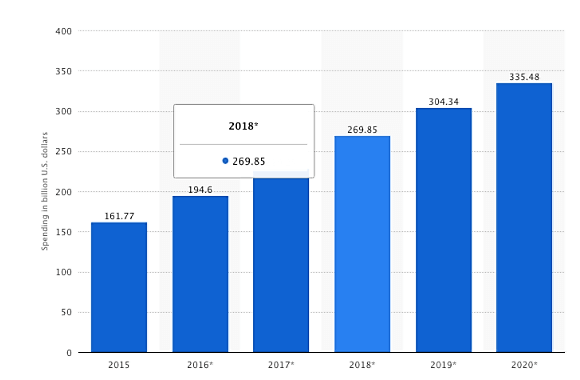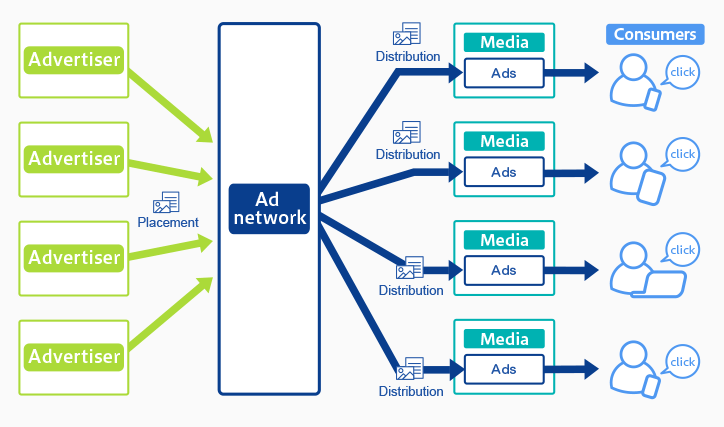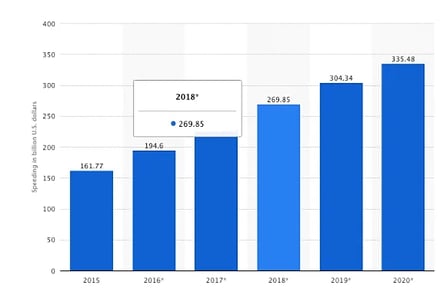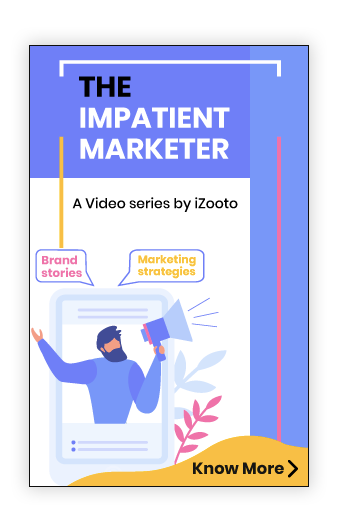There has been a drastic change within the digital advertising landscape. Ad tech as a whole has resulted in the formation of numerous businesses, each one offering a unique product or service that aids the overall online advertising process and adds value to the link between a publisher and an advertiser. These players are Ad Networks. With these new players in the ecosystem, the digital advertising model has evolved and is no longer the simple model of days gone by. It has evolved into a much more complex model.
It won’t be incorrect if I mention Ad Networks are the last option leveraged for paid advertising. For instance, If an advertiser has a budget of $100 for digital advertising, she might plan to spend $70 via Google, $20 via Facebook, $5 via Twitter, and only spend $5 or less via Ad Network.
In this article, I will try to broadly address how ad-networks function and how they have been able to drive growth. Before we start, here is a quick recap of the digital advertising scenario.
The fact that Google and Facebook have maintained almost a monopoly over digital ad expenditure at a global level (barring China) is not new to anyone. In the first quarter of 2017, as much as 92 cents of every new dollar spent on online advertising across the Asia Pacific (ex. China) went to Facebook and Google.
Of the $1.23 Bn in growth, $1.13 Bn goes to Google and Facebook. What is interesting is to understand how the remaining 8 cents are spent and spread across various platforms. The 8 Cents are primarily spread across Twitter, Linkedin, Native Advertising Platforms, and Ad Networks.
Digital Advertising Spending (In Bn USD)
Table of Content
- Campaign Types for Ad Networks
- How do these Ad Networks function
- Who should work with Ad-Networks?
- How do Ad Networks work with Advertisers?
- How do Ad Networks help publishers?
- There are broadly 3 types of Ad Networks
- Types of targeting available with Ad Networks
- Delivery Grid: Ad Formats Vs Type of Campaigns
- Top Performance Ad Networks in India
- Why should you choose or not choose to work with Ad Networks?
- Additional pros of working with Ad Networks
Campaign Types for Ad Networks
Cost-Per-Mille (Impressions)
In the CPM model a publisher the ad network for every 1000 ad impressions they deliver. CPM stands for Cost-Per-Mille, simply put Cost-Per-1000 Impressions.
Cost-Per-Click (CPC)
CPC, also called as PPC advertising campaigns, is performance-based (to an extent). As per the model, publishers get paid for every click they deliver to advertisers, with impressions not having a bearing on the payment at all.
Cost-Per-View (CPV)
As the name suggests, this model is based on the number of views the ad captures. These ads are not normal text ads, but rich media ads including video and display advertising. The tagline and the ad copy play a crucial role here. Read this article for some quick tips to become a pro at copywriting.
Cost-Per-Lead
The CPL model is entirely performance-based and takes into account qualified leads only. Unless and until all the criteria set up by an enterprise for lead qualification are met, the number of impressions, clicks on the ad, and landing page views don't matter.
Cost-Per-Sale
CPS is another performance-based metric that an affiliate Ad Network would work with. This goes a step further and considers only the number of sales that took place via the ad campaign.
Cost-Per-Install
CPI is applicable only in the case of apps. This model is ideal for businesses to leverage digital advertising to drive app installs.
Another concept that comes up in the case of app installs is the type of campaigns, whether the users are incentivized or not.
- Incentivized - The campaigns that run with this inventory type usually have a sweetener attached to them to attract the audience.
- Non - incentivized - This is a more genuine kind. This inventory does not have any associated offer to drive app installs.
CPL, CPS, CPI can together be termed as CPA (Cost Per Action), which is the absolute performance-based model.
Publishers and advertisers often use ad servers (more on this later) to maintain their own reports and serve ads, using third-party ad-serving tools or ad exchanges.
How do these Ad Networks function

Source: https://www.fancs.com/en/service/service2
An ad network is essentially a middleman that connects advertisers to websites that host advertisements. To be more precise, this network seeks out unsold advertising space from publishers and then sells that space to advertisers searching for ad space with particular content. When you see interactive ads being served on various sites you visit, there is a specific technical process taking place that enables such. Every Ad Network’s objective is to aggregate publishers in order to provide advertisers with low-cost ad space that can reach a lot of people.
Who should work with Ad-Networks?
Ad Network is a conscious choice that is made by many advertisers based on the objective they are planning to pull off with their ad campaigns. Do they only want to let people know about their client’s brand (usually a case with brands) or are they trying to generate revenue and some more complex business goals for their clients?
- For some, AdSense may suffice in the case of PPC advertising, but others find the bidding process tiresome and costly. For those who want to reach a lot of people with their branding campaign at a low cost, Branding Ad Networks could be a good choice. Furthermore, Ad-Networks can provide more assurance of consuming your inventory, most of the time.
- In the case of performance-based digital advertising where the aim varies from generating verified leads to selling products, Affiliate Ad Networks work great.
- If you are seeking full control over the campaigns and transparency with superior client service as compared to an Ad Exchange, Ad Networks are what you must opt for.
- Depending on the sophistication, Ad Networks help publishers serve targeted and contextual ads optimized as per the layout of the website/app.
How do Ad Networks work with Advertisers?
At the most basic level, ad networks pool an inventory of unsold ads from publishers and sell it to advertisers. Ad Networks earn money by taking a cut of the total ad revenue or basis the performance that is delivered.
Ads are delivered to a publisher’s site by an ad network’s ad server via the code on the publisher’s site that calls the ad. The performance of any campaign is tracked via a tracking pixel from the ad network that the advertiser places on the conversion page (landing page) such as a thank you page on its site. The ad network’s ad server powers ad targeting, tracking, and reporting on the campaign.
Unlike Google Adwords and Google Display Network where advertisers and agencies manage bidding, targeting, and optimization themselves, many ad networks manage campaigns on behalf of the advertisers. In such cases, an ad network and a buyer can negotiate all the costs and parameters associated with the campaigns including and not limited to
- Campaign duration
- Audience targeting
- Impressions (the number of times an ad is served) and
- Average cost per 1000 impressions (CPM).
The modern age Ad Tech stack makes the entire process less complex for advertisers.
How do Ad Networks help publishers?

Source: http://www.verticalrail.com/kb/ad-network/
Ad networks offer publishers an easy and convenient way to make money by selling space on a personal blog or another website. They link advertisers and publishers and offer a safe option for both to buy and sell.
Generally, it costs a blogger or a publisher nothing to partner with a network and implement a revenue stream. The network does all the work, from finding advertisers, to setting up campaigns, targeting, and collecting money. The network taking responsibility for these parts of the partnership leaves the publisher with time to create quality and relevant content, which is necessary to bring in revenue.
There are broadly 3 types of Ad Networks
- Blind Networks offer low prices, but advertisers generally have no control over the ad placement. Most of the ads, in this case, would appear on irrelevant websites, capturing irrelevant data and targeting irrelevant audiences.
- Vertical Networks tend to have higher quality traffic with advertising across general categories like automotive. In this case, the results an advertiser gets are of better quality as compared to what they would get with blind networks.
- Targeted Networks are the most expensive for advertisers, and focus on specific targeting like behavior or website context. Their data is filtered to the nth level and they often indulge in CPM game only.
 Types of targeting available with Ad Networks
Types of targeting available with Ad Networks
- Device - Advertisers can target their audience based on the devices (desktop, mobile, tablet) they use to visit the publisher’s site.
- Location - Ad Networks also allow publishers to target their audience in specific geographies.
- Other Tools:
- Campaign Duration - This feature allows advertisers to set the duration they want the ad to be live on the publisher’s site.
- Frequency Caps - With Ad Networks, it is also possible to set the frequency of an ad for any given user. For instance, you can set up an ad to appear only 3 times for a particular user. And it applies even if the user stays on the website for longer or comes back to the website more than thrice in a day.
Delivery Grid: Ad Formats Vs Type of Campaigns
| Method of Measurement / Method of Delivery |
CPI | CPL | CPS | CPC | CPM | CPV |
|---|---|---|---|---|---|---|
| Yes | Yes | Yes | Yes | Yes | ||
| Web page | Yes | Yes | Yes | Yes | Yes | Yes |
| Mobile App | Yes | Yes-Rare | Yes-Rare | |||
| SMS | Yes | Yes-Rare | Yes-Rare | |||
| Native | Yes | Yes | Yes | Yes | Yes | Yes |
| Video | Yes | Yes | Yes | Social | Yes | Yes |
Quality Metrics
The AdTech ecosystem has been plagued with challenges related to transparency. Everyone in the ecosystem right from Google, Facebook, and Snapchat to small ad networks has been under the radar at one point or the other. The fundamental rule that every advertiser expects and every publisher wants to adhere to are:
- Ads should be served only to humans or real users and not bots
While dealing with ad networks, advertisers have little control over the ad-serving process, because of which advertisers pre-define quality metrics that help them gauge the efficacy of the overall campaign. These quality metrics vary across categories and campaign types. Here is a quick overview of the quality metrics that have now become the standard in the performance marketing business in India.
Top Performance Ad Networks in India
There are over 500+ ad networks that operate with Indian advertisers and publishers. While this is a great number and gives publishers a lot of choices, given the issues around transparency, it is increasingly difficult to differentiate between these Ad-Networks. This is the problem that is faced by both advertisers and publishers and given the operational style of ad networks, this problem will continue to persist. From a publisher’s point of view, here are some of the factors governing the choice of ad network:
- Incoming Campaigns and Exclusives:
Affiliate businesses are laser-focused on delivering performance. Everything aside, performance or conversion rates heavily depend on the offer and whether or not that offer is exclusive to a publisher or not.
- Consistent Incoming Campaigns:
While publishers engage with multiple ad networks, they prefer allocating the bulk of their inventory to the ad networks that provide them with campaigns consistently.
- Campaigns with longer duration:
Like everyone else, publishers prefer working with ad networks that present them with campaigns that last longer. This gives them an opportunity to optimize their delivery, plan better, and essentially perform better.
- Campaigns that are exclusive:
Publishers love campaigns that present them with an exclusive offer. Campaigns with exclusive offers are exposed to select publishers and generally have lower payouts. Despite the low payout, publishers prefer exclusive campaigns because they are able to drive traction and improve their overall conversion rates.
- Payment Terms:
One of the most critical criteria for publishers is payment terms. Payment terms with Ad Networks vary drastically depending on the campaign and the publisher itself. For select campaigns, ad networks offer advance payments to kickstart the campaigns but on average, the payout period can vary between 30 - 90 days. This is where platforms like Google AdSense and Ad Exchange stand out. Google AdSense for instance processes payments in 30 days.

| Inventory | Quality Metrics | Remarks |
|---|---|---|
| CPI | Events + Retention |
|
| CPL | Verified |
Right party interested
|
| CPS | Sale without cancellation | |
| CPV | Cost Per Visit |
|
| CPM | Cost Per Impression |
Bounce Rate Click Rates (2% and above)
|
| CPC | Cost Per Click |
CTR ~ 5% Bounce Rate (<50%)
|
| CPI | CPL | CPS | CPC | CPM | CPV | |
|---|---|---|---|---|---|---|
| vCommission |
Banner Ads
Mobile app
Native
Social
Video
|
Banner Ads
Mobile app
Native
Social
Video
|
Banner Ads
Mobile app
Native
Social
Video
|
Banner Ads
Mobile app
Native
Social
Video
|
Banner Ads
Mobile app
Native
Social
Video
|
Banner Ads
Mobile app
Native
Social
Video
|
| iCubes Wire |
Banner Ads
Mobile app
SMS
Native
Video
|
Email
Banner Ads
Mobile app
SMS
Native
Social
|
Email
Banner Ads
Mobile app
SMS
Native
|
Email
Banner Ads
Native
SMS
|
Email
Banner Ads
Video
Native
Social
|
Email
Banner Ads
Video
Native
Social
|
| PaYesoom |
Banner Ads
Mobile app
SMS
Native
Social
Video
|
Email
Banner Ads
Mobile app
SMS
Native
Social
|
Email
Banner Ads
Mobile app
SMS
Native
|
|||
| AdmitAd |
Banner Ads
Mobile app
SMS
Native
Social
Video
|
Email
Banner Ads
Mobile app
SMS
Native
Social
|
Email
Banner Ads Mobile app
SMS
Native |
Email
Banner Ads
Mobile app
SMS
Native
|
Email
Banner Ads
Video
Native
Social
|
Email
Banner Ads
Video
Native
Social
|
| Optimize |
Banner Ads
Mobile app
SMS
Native
Social
Video
|
Email
Banner Ads
Mobile app
SMS
Native
Social
|
Email
Banner Ads
Mobile app
SMS
Native
|
Email
Banner Ads
Native
SMS
|
Email
Banner Ads
Video
Native
Social
|
Email
Banner Ads
Video
Native
Social
|
| Media.net |
Native
Video
|
Video
Native
|
Native |
Video
Native
|
Native
|
Video
Native
|
| Komli |
Banner Ads
Mobile app
SMS
Native
Social
Video
|
Email
Banner Ads
Mobile app
SMS
Native
Social
|
Email
Banner Ads
Mobile app
SMS
Native
|
|||
| DGM |
Banner Ads
Mobile app
SMS
Native
Social
Video
|
Email
Banner Ads
Mobile app
SMS
Native
Social
|
Email
Banner Ads
Mobile app
SMS
Native |
Email
Banner Ads
Native
SMS
|
Email
Banner Ads
Video
Native
Social
|
Email
Banner Ads
Video
Native
Social
|
| SVG |
Banner Ads
Mobile app
SMS
Native
Social
Video
|
Email
Banner Ads
Mobile app
SMS
Native
Social
|
Email
Banner Ads
Mobile app
SMS
Native
|
Email
Banner Ads
Native
SMS
|
Email
Banner Ads
Video
Native
Social
|
Email
Banner Ads
Video
Native
Social
|
| ClickZoot |
Banner Ads
Mobile app
Native
Video
|
Banner Ads
Mobile app
Native
Video
|
| CPI | |
|---|---|
| Rationalhead |
Banner Ads
Mobile app
Native
Social
Video
|
| Taskbucks |
Banner Ads
Mobile app
Native
Social
Video
|
| Pokkt |
Banner Ads
Mobile app
Native
Social
Video
|
| ITM-adcall |
Banner Ads
Mobile app
Native
Social
Video
|
| Mob-Vista |
Banner Ads
Mobile app
Native
Social
Video
|
| Ladoo |
Banner Ads
Mobile app
Native
Social
Video
|
| Incent Only | |
| Incent & Non-incent |

| Ad Network | Ad Exchange |
|---|---|
| Direct contact with Ad Networks, more visibility, and transparency in campaigns. | Entirely based on a bidding process that reduces transparency and doesn’t allow the advertiser to have control over the campaign. |
| Higher fill rates but lower CPC and CPM. | Higher bids require a higher overall campaign budget. Can not be used for performance-based campaigns. |
| A better option is in the case of performance-based campaigns (CPL, CPI, and CPS). | Running bulk campaigns with Ad Exchange can be chaotic for an advertiser. |
| More assurances of the ad being run on a relevant site. Campaign targeting is available. | Lesser options for campaign targeting. |
| Superior client service. Better control of what campaigns you run/don’t run. | High chance of your ad being displayed on a partner site that is not at all contextual. |
The above factors can help you choose between the two, however, the differentiating factors, in any case, would be the campaign objective and the target audience. If you are looking for acquisition then you can very well rely on Ad Networks. If you want to run branding campaigns, you can juggle between the two, but make sure you analyze all the factors associated with the two.
Source: http://www.mediative.com/rtb-programmatic-direct-private-marketplaces/
Above is an elaborate diagram depicting the functioning of Ad Exchanges. Here, what Ad Networks will do is turn this complex process into a not-so-complex one for advertisers as well as publishers.
Why should you choose or not choose to work with Ad Networks?
Ad networks have long been a core component of any media plan. While in the early days of online advertising, Ad Networks struggled to justify their existence, they now are welcomed in every major advertising budget thanks to their reach and scalability.
Traditional ad networks can provide immediate results — and working with an ad network facilitates understanding of the marketing challenges, the ever-changing dynamics, and the science behind driving greater value from online advertising.
Moreover, the prolific growth in consumer-generated content/media has seen an increasing number of ad networks with varied models that take advantage of the mounting power of social networks. The available targeting with Ad Networks allows advertisers to constantly evaluate and refine the networks’ inventories based on which sites become part of influential and relevant conversations.
Additional pros of working with Ad Networks
- Dedicated support
Dedicated client support available in the case of Ad Networks is definitely something that tends to lure advertisers.
- Cost Effective and efficient
As Ad Networks charge on a CPA basis, there’s more accuracy in terms of average revenue per user
- Convenience
By taking care of all the ad elements, Ad Networks make the entire advertising process less chaotic and more convenient for advertisers. All they have to do is to get in touch with the right Ad Network and share their campaign requirements.
- Available targeting
Extensive targeting available with Ad Networks helps advertisers enhance their overall campaign performance and acquire more users.
Cons and possible risks
- Fake traffic
A non-human traffic trend seems to be steeply expanding in this market which means that there is quite a good chance that you are being conned by the data that you see and hence wasting your advertising budget.
- Doubtful lead quality
Ad Networks are often alleged to fabricate the generated leads. However, this happens mostly when you are using Ad Network with a bad name.
- Payment terms
Cases of delayed payments towards publishers are quite common.
Over To You
The bottom line is that there are Ad Networks that deliver great results and there are many that don't. It is recommended to do your research based on your objective and choose the right Ad Network for your business.
*If you think some data is missing or needs to be changed, feel free to get in touch.







